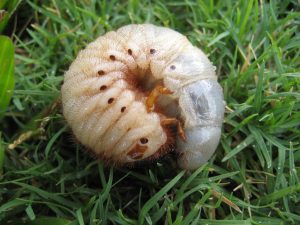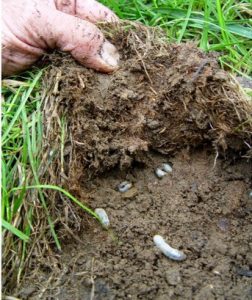 Grass grub is found throughout New Zealand and is considered New Zealand’s major lawn pest. It attacks the roots of grasses and other plants.
Grass grub is found throughout New Zealand and is considered New Zealand’s major lawn pest. It attacks the roots of grasses and other plants.
Grubs can be found within your lawn during the late summer months after the beetles have laid their eggs around July. Female beetles lay their eggs about one or two inches deep in the soil.
Grass-grub larvae are soil-dwelling grey/white grubs up to 15 mm long with tan colored heads. Typically found lying in a C shape. They feed on the roots of many pasture species and other plants.
Recent news reported for their nuisance were as follows:
This native pest is costing our economy millions – and it’s not alone
Pat Deavoll │ October 02 2018
 They’re small and hungry, and a new report says they’re costing us about $500 million a year in damage.
They’re small and hungry, and a new report says they’re costing us about $500 million a year in damage.
They may be only a centimeter long – but with thousands of relatives, the native grass grub has been causing havoc to pastures and crops around New Zealand for the last 100 years.
In fact, a recent AgResearch study showed the impact of the pasture-pest was costing dairy farmers up to $380 million and sheep and beef farmers up to $205m each year, making it our most expensive pest.
Grass grub is an ongoing problem for the agricultural industry, and while research into control of the grass grub has been happening, an answer to its total eradication remains elusive.
Dead grass? Utah grubs may be to blame
By Intermountain Farmers | July 6, 2016
 If you have dead spots in your beautiful lawn, chances are you want those areas restored to their dark green color as soon as possible. Usually, the culprit is damage caused by lawn grubs and immediate action is required.
If you have dead spots in your beautiful lawn, chances are you want those areas restored to their dark green color as soon as possible. Usually, the culprit is damage caused by lawn grubs and immediate action is required.
However, dead patches may also be the result of not enough watering, especially in the hot summer. Sometimes sprinklers don’t cover all the areas in a lawn adequately or you may have a plugged sprinkler head you are not aware of.
Several insecticide products are available that are used widely. But these are harmful to humans as well as the environment since it degrades the soil. Using pesticides to combat the nuisance is not a feasible way.
C Tech Corporation can offer an eco-friendly solution to the nuisance caused by the corn rootworm. Our product CombirepelTM is low-toxic, non-hazardous and insect aversive. Our products work on the mechanism of repellence and they do not harm or kill the target species but generate fear or trigger temporary discomfort within the pests that keep the pests away from the application.
Our product works on the mechanism of repellency. It temporarily inhibits the mating cycle of the insects. The product impairs the ability of the insects to reproduce, that is the insects will not lay eggs or the laid eggs will be infertile. The product causes feeding disruption in an insect by triggering an unpleasant reaction within the insect which might try to feed on the application. The product temporarily blocks the reproduction system of the insects by hindering the release of the vital hormones for growth.
Our product is compliant with EU – BPR, RoHS, RoHS2, ISO, APVMA, NEA and REACH and is FIFRA exempted. The green technology-based product can protect the plants and prevent the loss caused by the grass grub and other insects as well.
CombirepelTM is available in lacquer form. These products can be directly sprayed or applied to the application as a topical application. It can be applied to the already laid pipes and tubing in the garden. The lacquer is compatible with most of the surfaces like wood, metal, concrete, polymers, ceramics, etc.
Our CombirepelTM masterbatch can be incorporated with various polymeric applications like agricultural and other protective films, pipes, wires, and cables etc. while they are manufactured. This will prevent the pests from gnawing on the polymeric application.
CombirepelTM is available in liquid concentrate which can be mixed in paints and be applied on the fences in the garden and farms. Thus, using our products, you can get an effective solution to fight menace caused by grass grub and many such insects!
Contact us at technical.marketing@ctechcorporation.com to keep the pests away.
Also, visit our websites:
http://www.ctechcorporation.com/
http://www.rodrepel.com/
http://www.termirepel.com/
http://www.combirepel.com/
Follow our Facebook pages at:
1] https://www.facebook.com/Combirepel-411710912249274/
2] https://www.facebook.com/Termirepel-104225413091251/
3] https://www.facebook.com/Rodrepel-120734974768048/
Follow us on our Twitter pages at:
1] https://twitter.com/rodrepel
2] https://twitter.com/termirepel
3] https://twitter.com/combirepel
